Decorative screen panels are a versatile home decor element that can be used in many creative ways to add style, function and privacy to your space.
I’m always looking for multifunctional pieces that make the most of limited room.
Screen panels fit the bill perfectly.
Rather than limiting screen panels to only room dividers or standalone art pieces, think outside the box for other innovative uses.
For example, you can use screens as a room dressing to define different areas like a living room seating section or dining nook.
Place one on its side against a wall for an accent wall with visual interest.
Screens also work well in small bedrooms or living areas to conceal a cluttered area like a laundry basket or equipment without blocking access.
Use them to cordon off an unused corner or alcove as an impromptu workspace.
Outdoor screens provide shade and breathing room on a porch or patio.
Some other creative screen panel applications include room separates without blocking views, backdrop for indoor plants, display shelving, open closet doors, hiding utility boxes, kitchen splash guards and even headboards over beds for privacy without enclosing the space.
The goal is to find new functions beyond basic room division.
Screen panels offer flexibility to customize the look and flow of your unique living space.
I hope these ideas spark your creativity to utilize them in innovative ways.
✨Click to Get My 101 FREE Designer Room Ideas
Room divider – Use screens to separate rooms without blocking sightlines or airflow
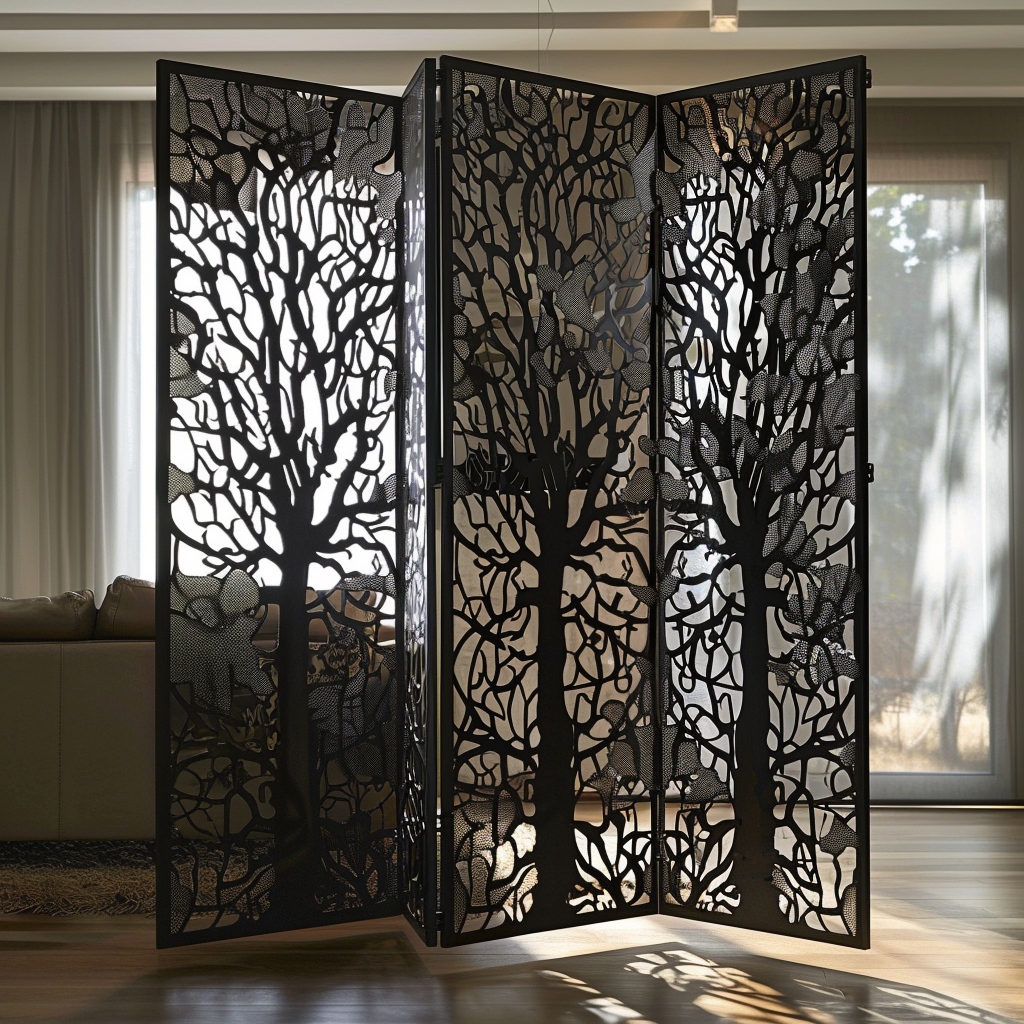
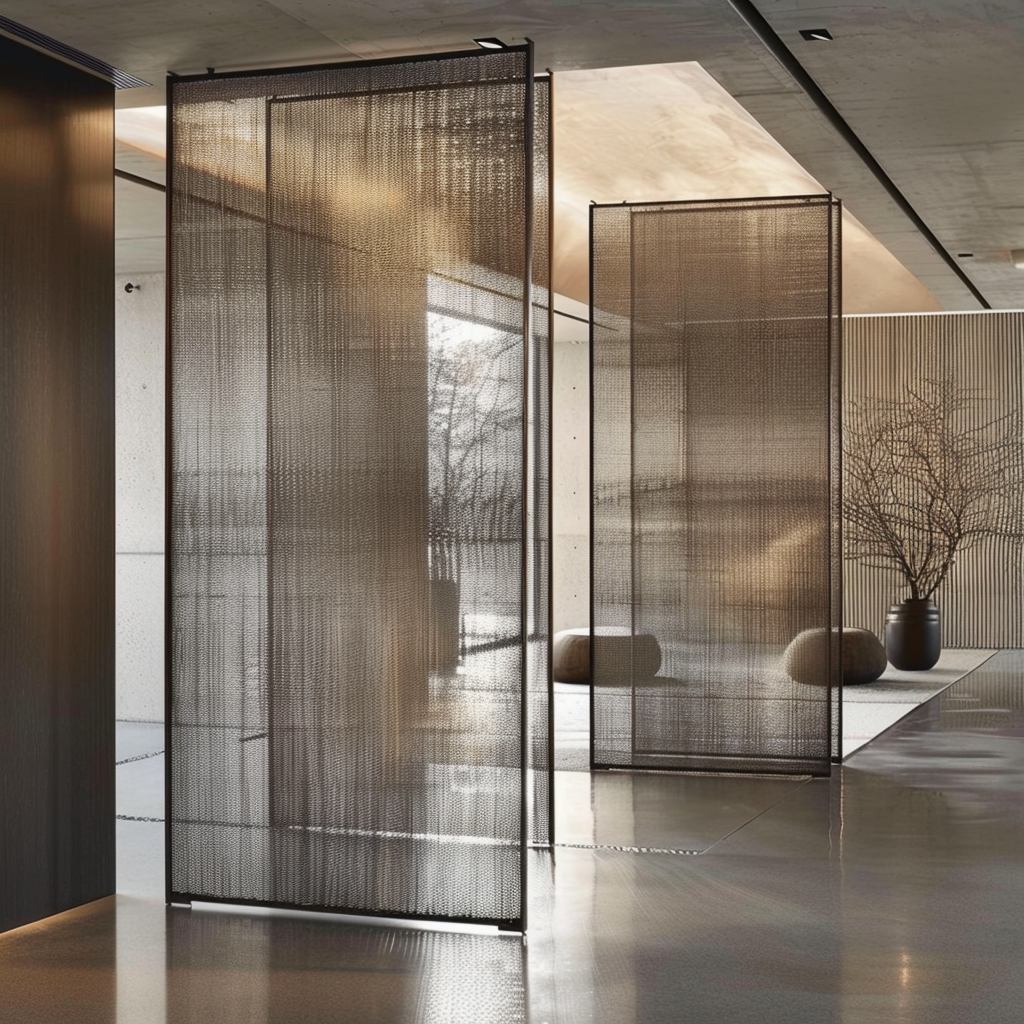
One of the most versatile uses of decorative screen panels is as a room divider.
Screens allow you to aesthetically define separate spaces within an open floor plan, without completely closing off the areas from each other.
This is ideal for everyone still wanting that open concept flow.
Screens keep rooms visually separate while preserving sightlines.
You can see into the adjacent area but maintain some privacy and division of use.
The open design also permits cross breezes and airflow to pass through naturally.
This prevents spaces from feeling closed off or stuffy.
When setting up screens as dividers, choose panels that are nearly as tall as the ceiling to fully separate the overhead space.
You can also daisy chain multiple narrow screens together to create a longer partition as needed.
Mount them on attractive sliding hardware or freestanding frame stands for flexibility to open or close off areas as preferred.
Choosing screens with interesting cutout patterns, woven textures or bold graphics adds visual depth and character as a room separator versus a plain divider.
Lights or plants can also be layered behind the open portions to accent the screen further.
Whether splitting a great room, defining separate play and living spaces, or cordoning off a bedroom nook, decorative screens expertly partition areas without compromising openness.
They keep interiors feeling airy while still providing adaptability, privacy and defined usage when preferred.
Accent wall – Lean a screen panel vertically against a wall for visual interest
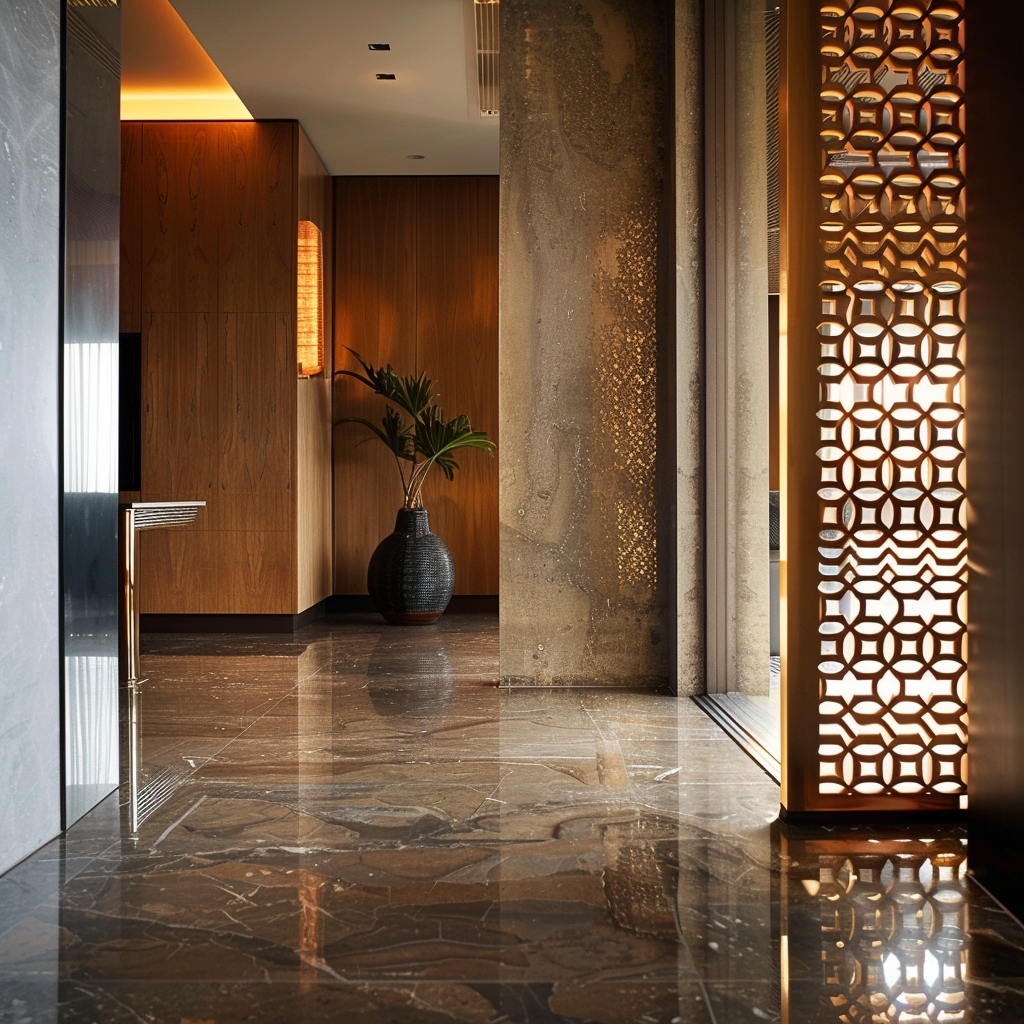
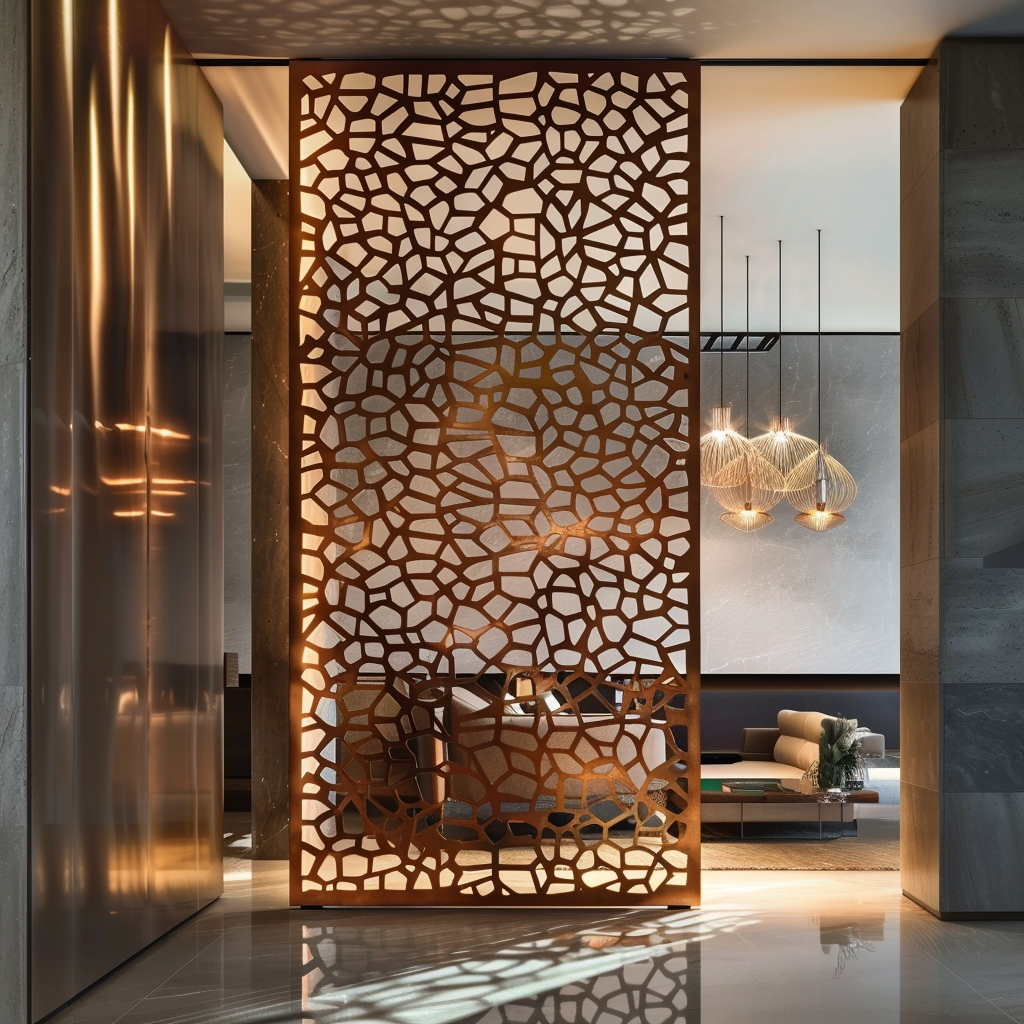
Lean a floor-to-ceiling screen vertically against a wall to create an instant focal point and boost visual interest in a room.
Screens make for an eye-catching alternative to regular wall art or paneling.
Their linear details, woven textures, cut-out patterns or printed graphics call attention even from a distance.
Position the accent screen where you want the room’s conversation or activities to center, such as:
- Behind a couch or seating area to provide an engaging backdrop
- Along a short wall at the kitchen dining area to divide and decorate
- At the end of a hallway to designate the end point
Consider mounting the screen partially or fully to remove potential tipping hazards if small children are present.
Lean at a slight outward angle from the perpendicular for aesthetic balance.
Make sure the design and color palette complement the overall room scheme.
Lighting behind or on the screen after dark creates an attractive display element.
Add plants, objects or built-in shelving behind for extra dimension.
A focal screen accent lends visual depth, interest and style to a room in a low commitment way.
It dresses up a blank wall and sets a design foundation to build out the overall interior.
Seating area definition – Define different sitting sections within an open concept area

In open concept spaces where the living, dining and kitchen areas flow together, screen panels are ideal for subtly defining dedicated seating sections.
This allows you to maintain an open vibe while still distinguishing discrete zones for different functions.
You can section off the:
- Living room seating from the main throughway
- Conversation area from the TV watching space
- Daybed nook from the main living area
Arranging multiple panel screens in an L-shaped or zig-zag configuration helps envelop the seating space.
Opt for transparent or lightly patterned screens so conversation can still cross.
Freestanding tensioned screens on wheels provide flexibility to rearrange as needed.
Or mount on rails on the ceiling or tracks on floors for a clean look.
Group complementary furniture, lighting, textures and accessories within each defined section to further distinguish the zones without walls.
Screens help establish order and purposeful space without closing things off.
It creates defined areas where larger groups can comfortably congregate without infringing on different activities simultaneously occurring in the open concept space.
Privacy screen – Strategically place screens around a bedroom, bathroom or home office for discretion
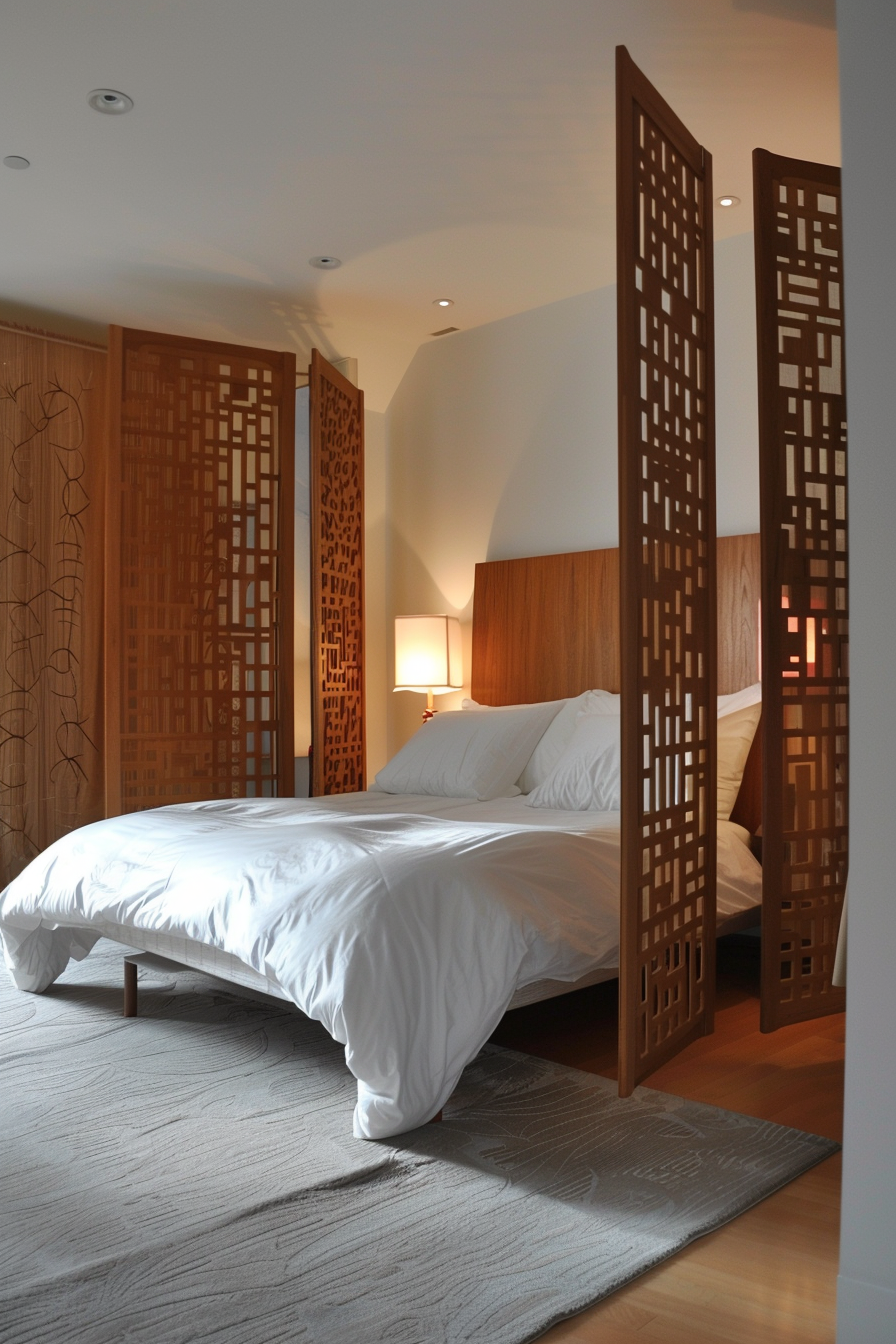
Screens make excellent privacy buffers for shared or multi-purpose spaces where a solid wall isn’t feasible.
Some ways screens provide discretion include:
Bedrooms:
– Mount a screen around the bed headboard area for sleeping privacy without enclosing the space.
– Separate a bedroom alcove or nook for a dedicated work/reading zone.
Bathrooms:
– Place a screen outside an open shower area to shield against passersby.
– Dress a half wall around a tub for modesty without feeling closed-in.
Home offices:
– Cordon off a workspace within an open living area for focus without blocking light.
– Screen off a home office area located near a shared hall or common space.
Strategically located opaque or semi-transparent screens allow glances of activity behind without compromising privacy.
Mount screens on ceiling tracks or leaning hardware for adjustable convenience.
Focus on designs that complement the space’s style while also providing needed discretion.
Opt for neutral colors that blend discretely without feeling like an afterthought.
Screens provide a lightweight yet effective way to parcel off shared spaces compared to permanent wall structures that close rooms off completely.
✨Click to Get My 101 FREE Designer Room Ideas
Conceal a clutter catchall – Hide items like shoes, coats or toys behind a screen

In high-traffic areas like entryways, mudrooms or family rooms, it seems clutter has a way of multiplying if not kept contained.
Rather than an eyesore, turn that necessary “stuff” into organized displays behind a decorative screen.
A tall, narrow screen mounted on the wall makes an ideal partition to conceal shoes, coats, toys, sports gear or other bulky seasonal items without blocking functionality.
Make sure to choose a screen style that matches the aesthetics so it doesn’t scream “clutter zone!”
Mount the panel in a logical spot near the entry, garage door or main living zones for easy access while disguising the mess.
Leave some clearance around the screen for lightweight items like scarves or mittens to be hung within reach too.
For a polished look, add pegs, cubby holes or open shelving built into or mounted behind the screen panel.
This keeps belongings organized by category yet hidden from general living areas.
Alternatively, use old wooden pallets, planks or decorative bins placed discreetly behind for catching loose items.
Consider lighting here for evening visibility.
Having a catchall nook neatly concealed saves floor space and prevents everyday essentials from muddying the visual flow elsewhere in your home.
Hidden clutter ceases to be an eyesore, freeing you to focus on design everywhere else!
Alcove define – Cordon off an unused nook as an impromptu desk space or reading nook


Many homes have odd-shaped unused nooks or alcoves that are perfect for repurposing as a dedicated work or reading area.
Rather than leaving it unused, cordon it off as your new impromptu office or escape.
Look for shallow alcoves under staircases, in wide hallways or odd triangular spaces without a fixed purpose.
Assess lighting and electrical/data outlets nearby.
Then craft the area into a semi-private functional zone:
Place a tall, narrow screen panel mounted on one side of the nook, matching the ceiling height.
This defines the boundaries of your new dedicated space.
Add a small desk, table or daybed within for comfortable working/reading.
Overhead or wall lighting ensures nighttime usability.
Stock the area with office essentials, books, plants or décor items that create an inviting ambiance related to its purpose.
Storage underneath or behind the screen keeps it clutter-free.
Leave gaps at bottom and top of the screen to prevent feeling enclosed while still delineating your new sanctuary.
Add cutouts or semi-transparent panels for some visibility through.
Now a formerly wasted alcove serves you productively as a semi-private retreat without major renovations—a great use of otherwise dead space!
Outdoor privacy – Provide separation and shade on a patio or porch without enclosing the space
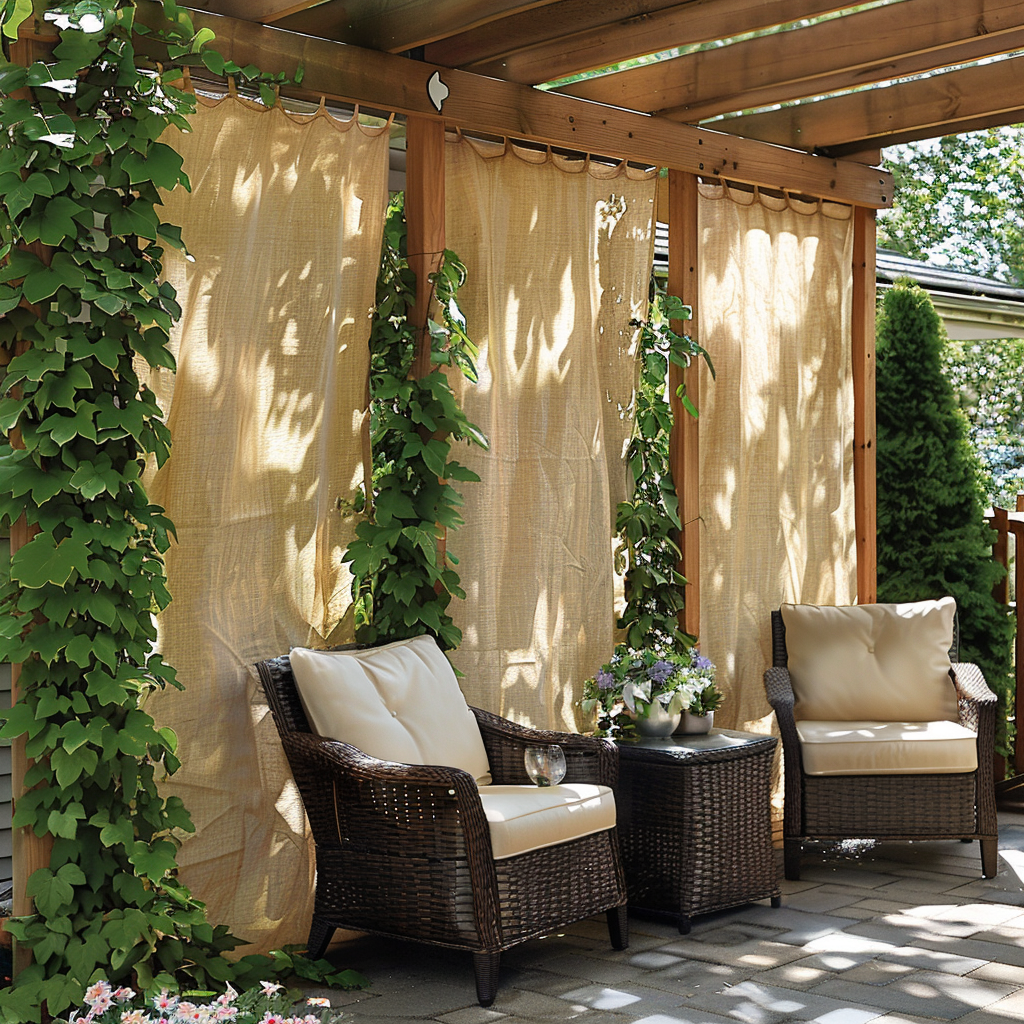
If you entertain often on your patio or enjoy lounging on your porch, screens make attractive alternatives to full privacy fences or hedges.
They allow sunlight and views in while maintaining discreet separation from neighbors.
Choose weather-resistant screen designs made of aluminum, powder-coated steel or exterior-grade wood to withstand rain, sun and wind.
Opt for open crisscross or linear grill patterns to diffuse light and breeze without blocking it.
For a patio, arrange multiple screens in an L-shape or zig-zag configuration to fully envelop the space and shield from view each side.
Mount them securely on sturdy posts at enough height for headspace.
On a porch, lean single tall screens along the perimeter railings or attachments points on the ceiling above seating areas.
Add potted plants or hanging baskets on supports to further shield gaps.
Not only do outdoor screens provide a sense of enclosure on a deck or veranda, but their horizontal and vertical planes also effectively diffuse harsh sunlight without blocking natural light.
This keeps the space usable even in midday heat.
With screens’ decorative latticework and careful positioning, you maintain a fluid indoor-outdoor flow while discreetly partitioning your retreat from outside onlookers and elements.
Plant backdrops – Use screens as a backdrop to elevate and better display houseplants
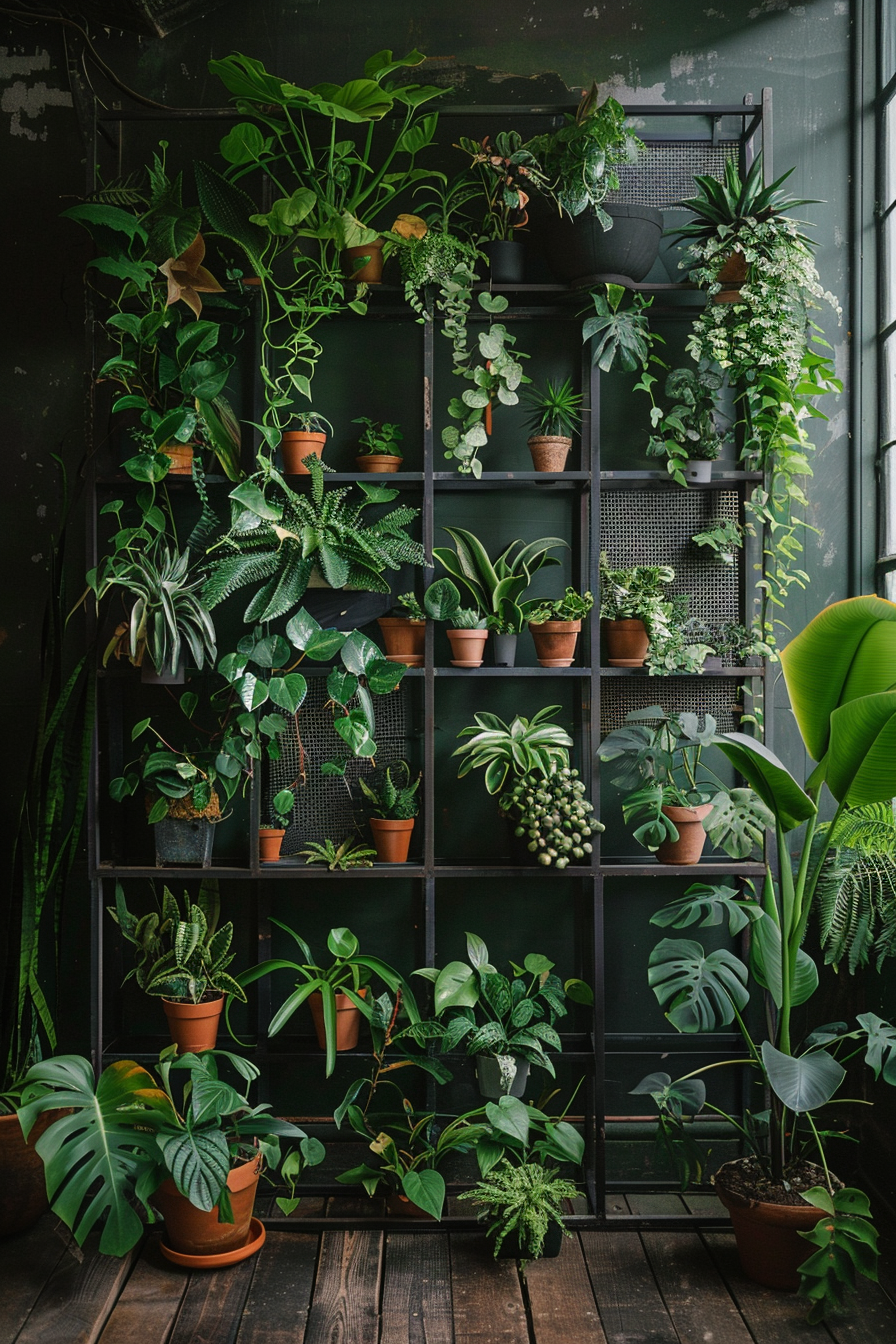
Houseplants add life and texture indoors, but pondering where to place them amid your interior design can be a challenge.
Decorative screens make ideal backdrops that display plentiful greenery beautifully without cluttering surfaces.
Secure panels to walls in high-traffic rooms like living areas, kitchens or home offices where plants and their benefits will be appreciated often.
Choose grate or open-patterned screen styles to allow plant foliage to peek through.
Then install hanging plant shelving or ledges behind at varying heights.
Moist, bright tropical or trailing vines look especially lush in this setting.
Consider combining plant varieties with varied leaf shapes and colors for visual interest.
Display smaller potted plants on open screen shelving installed directly behind.
Their placement acts as an accent rather than taking up precious tabletop real estate.
Subtly-integrated grow lights or fixtures behind maintain vigorous plant health without competing with your interior lighting scheme.
Integrated irrigation systems keep greenery well-watered.
This wall-mounted, multi-level showcase for your plant collection enhances air purification and ambiance indoors, while disguising messy gardening equipment storage behind.
Win, win!
Screens framed with leafy companions make dramatic backdrops for your brand of indoor jungle without overpowering existing décor.
Plants are showcased to best advantage this way.

✨Click to Get My 101 FREE Designer Room Ideas
Display shelving – Add decorative screens above furniture for floating shelving displays

Decorative screen panels mounted above living room furniture, dining tables or bedroom dressers make unique shelving surfaces for displaying small accessories, photos or collectibles.
Compared to bulky built-in cabinetry, screens create a lighter, more open aesthetic.
Carefully measure the wall space above targeted furniture pieces to plan screen placement.
Mount slim screens horizontally or in grid formations using hidden wall brackets or ceiling tracks integrated into the panel designs.
This “floating” installation creates the illusion of shelves suspended elegantly in air.
Feature lower-profile display items that won’t interfere with easy viewing from below.
Drape air plants, string warm string lights, or arrange complementary objet d’art, framed photos and mementos on the open screen surfaces.
Choose open screen patterns to avoid blocking wall space.
For living rooms, group favorite books, small sculptures or tabletop décor on screen shelves above sofas where they can be easily admired from the seating area.
In dining rooms, reserve screen shelves to frame room focal points like artwork or candles placed among china sets and serving pieces.
The end result is a gallery-style display integrated seamlessly into interior architecture, versus standalone cluttered shelving.
It elevates everyday spaces and collections in a light, unencumbered manner.
Open closet doors – Mount screens in place of bi-fold or sliding doors to keep closets neat

Many closets have bi-fold or sliding doors that take up valuable floor space when opened wide for accessing clothes and storage.
Mounting an open decorative screen panel in its place saves real estate while keeping closets organized.
Choose a single screen panel design with an airy cut-out pattern or one constructed of lightweight material like bamboo that can be mounted directly onto a closet opening with no door track required.
Install the screen using simple wall brackets positioned high and low within the doorway framing.
This allows easy lifting on and off if deeper closet cleaning is ever needed.
With light filtering through, the screen keeps contents neatly out of sight from the bedroom while still illuminated enough for finding items.
Mount small hanging shelves or racks inside at varying heights to double the storage capacity.
Add slim garment rods spanning the opening width-wise a few inches in front of the screen to keep hanging items organized yet discreetly hidden.
Screen “doors” prevent closet overflow from littering the bedroom floor yet don’t block valuable floor space like traditional doors would when open for dressing.
Plus they inject character into an otherwise utilitarian space.
Utility box cover – Camouflage unsightly utility boxes or equipment with a screen panel

Unsightly utility boxes, large thermostats, cable/internet modems or PV solar panels installed on exterior home walls can be eyesores that detract from curb appeal and interior design schemes.
Decorative screens provide an attractive solution.
Measure the dimensions of the box/equipment and allow room for ventilation.
Choose a screen style and mounting system appropriate for outdoor/high-moisture areas if exterior.
Opt for solid styles if blocking functionality is preferred over airflow.
Cut panels to size and mount securely covering all sides using durable exterior-grade hardware.
Leave space around edges and backside for air circulation/access if needed.
Paint screen frames to coordinate with your wall/trim colors for seamless blending.
Install low-wattage LED lights behind exterior screens at night for safety and ambience.
Indoors, conceal unsightly wall-mounted water heaters, air filters or junction boxes the same way using interior-rated screen materials and mounting hardware.
Rather than an afterthought, screened panels disguise utilitarian needs attractively within your intentional design aesthetic both inside and out.
Functionality stays intact while curb and interior appeal remains tidy.
Kitchen splash guard – Shield against food splatters behind a range or sink area
The area behind a range or sink tends to collect food splatters, grease splashes and general mess over time.
A properly placed decorative screen prevents this while protecting your walls.
Measure the backsplash and cabinetry space you want to shield.
Choose a durable, easily cleaned screen style – such as a tightly woven metallic design.
Mount it securely using concealable brackets at the top and bottom.
For range hood coverage, ensure the panel extends the full height and depth of the hood area.
Leave an inch or two of clearance around the edges for ventilation.
A tall, narrow screen placed at a slight distance behind the sink collects drips without blocking work space.
Make sure the bottom edge is raised several inches above the countertop.
With the screen installed, you can protect the wall from spatters during cooking without an ugly plastic guard.
Its decorative appeal means no sacrifice to your design.
Periodically remove the screen and wipe it down for deep cleaning access behind.
The cutouts will still allow enough visibility and airflow versus a solid panel.
A decorative splash screen shields décor while adding visual interest to your cooking zone environment.
No more mess hiding behind it over time!
✨Click to Get My 101 FREE Designer Room Ideas
Room dividers with character – Use screens as headboards, footboards or room separators to define space
Screens make unique room dividers that allow airflow and views while neatly separating zones.
Consider them:
- As headboards – Mount matching screen panels to the tops of two facing beds for a “wall” between.
Add sconces behind for reading.
- As footboards – Attach screens vertically to the foot of each bed as a barrier without enclosing space.
Decorative hardware elevates this.
- Along walls – Mount screens on sides of shared sleeping areas, offices or playrooms at the ceiling to define the perimeter.
- As a freestanding idea – Connect multiple panel screens on casters or bases to create a temporary or portable configuration.
Choose panel designs with character like woven wooden grates, iron filigree or nature-inspired motifs.
Uplighting behind at night adds dramatic ambiance.
To define open living spaces, arrange a series of tall, narrow screens at varying depths.
Curved panel styles envelop areas gracefully.
Compared to solid walls or furniture, screens allow cross-breezes and communication while establishing visual boundaries.
Pair unique designs with textures and schemes to define distinct yet fluid zones.
Their see-through aesthetic maintains an open ambiance better than closed-off walls alone for harmonious flow throughout interior architecture.
Decorative screen panels provide versatile and practical solutions for privacy, organization and aesthetics throughout the home.
Their lightweight and customizable nature allows discreetly defining spaces without blocking light or views.
From dividing rooms and closets to outfitting outdoor areas, screens offer privacy without closing areas off completely.
Their decorative latticework infuses character into functional areas like bathrooms, kitchens and alcoves while disguising necessary clutter or equipment.
Whether used as room dividers, splash guards, plant backdrops or shelving displays, screens elevate interior and exterior design with unique personality.
Their diverse applications make them worthwhile additions to any home, providing both form and function elegantly.

